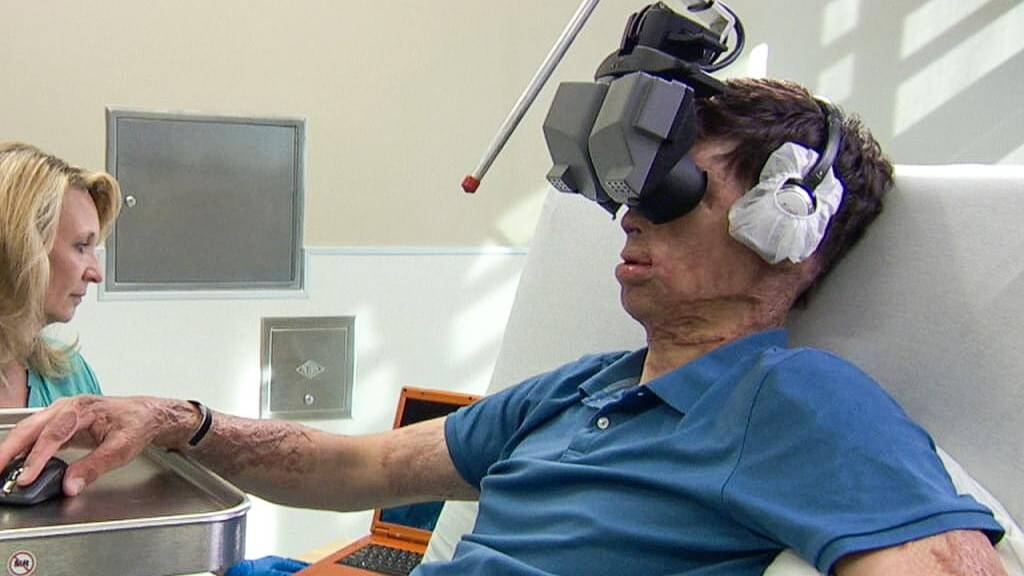"We’re interested in understanding how we can use different technologies to improve the patient experience in ways that don’t require more drugs, and VR is one of them" says Brennan Spiegel, director of health services research at Cedars-Sinai.
Many medical procedures and tests performed in every hospital are associated with stress or pain. For example, during blood drawing or inserting an intravenous line. In some cases, the patient's fear is paralyzing. To minimalize pain and distract the patient's attention, the virtual reality technology might help.
Thanks to 3D headset, the hospital room can be replaced with a green park, a sunny beach or a mysterious planet. "The VR helped me get through what I was so fearful of – like that I wasn’t able to do it – and I delivered my baby without any assistance of drugs" says Erin Martucci, 42, who tried VR goggles for the first time. During the procedure, she entered a beach scene. Virtual woman’s voice went through the breathing with her. "Having the visual and narration definitely calmed me down and took away that anxiety, and I knew that I could do it without the epidural" she adds.
[caption id="attachment_24886" align="aligncenter" width="640"] SnowWorld – a game that changes hospital room into an icy polar world where patient can throw virtual snowballs at penguins and snowmen.[/caption]
"Maybe VR can complement a lower dose of pain medication or will eliminate the need for medicine altogether for some patients, which would be optimal" says Jeffrey I. Gold, director of the Pediatric Pain Management Clinic at Children’s Hospital Los Angeles, where VR is in use since 2004. Virtual reality has become there a part of hospital culture, helping to deliver better patient care.
Virtual reality as a therapy for pain is not a new idea. Already in 1990 researchers started to study the application of VR in medicine. A growing interest in virtual reality distraction therapy and a widespread use came first with a fast technological advancement. Today, VR headsets have become affordable and smaller.
A number of studies shows promising results. In a study involving 18 patients, Theresa McSherry – a nurse practitioner at the Oregon Clinic in Portland – and her colleagues found that “VR reduced the amount of opioid medication requested from patients by 39 percent”.
Despite many studies and growing excitement, virtual reality still has to overcome some barriers. For many it’s still unproven technology. The cost of VR headset remains relatively high. Too less large studies have been done do prove VR’s benefits.
SnowWorld – a game that changes hospital room into an icy polar world where patient can throw virtual snowballs at penguins and snowmen.[/caption]
"Maybe VR can complement a lower dose of pain medication or will eliminate the need for medicine altogether for some patients, which would be optimal" says Jeffrey I. Gold, director of the Pediatric Pain Management Clinic at Children’s Hospital Los Angeles, where VR is in use since 2004. Virtual reality has become there a part of hospital culture, helping to deliver better patient care.
Virtual reality as a therapy for pain is not a new idea. Already in 1990 researchers started to study the application of VR in medicine. A growing interest in virtual reality distraction therapy and a widespread use came first with a fast technological advancement. Today, VR headsets have become affordable and smaller.
A number of studies shows promising results. In a study involving 18 patients, Theresa McSherry – a nurse practitioner at the Oregon Clinic in Portland – and her colleagues found that “VR reduced the amount of opioid medication requested from patients by 39 percent”.
Despite many studies and growing excitement, virtual reality still has to overcome some barriers. For many it’s still unproven technology. The cost of VR headset remains relatively high. Too less large studies have been done do prove VR’s benefits.
 SnowWorld – a game that changes hospital room into an icy polar world where patient can throw virtual snowballs at penguins and snowmen.[/caption]
"Maybe VR can complement a lower dose of pain medication or will eliminate the need for medicine altogether for some patients, which would be optimal" says Jeffrey I. Gold, director of the Pediatric Pain Management Clinic at Children’s Hospital Los Angeles, where VR is in use since 2004. Virtual reality has become there a part of hospital culture, helping to deliver better patient care.
Virtual reality as a therapy for pain is not a new idea. Already in 1990 researchers started to study the application of VR in medicine. A growing interest in virtual reality distraction therapy and a widespread use came first with a fast technological advancement. Today, VR headsets have become affordable and smaller.
A number of studies shows promising results. In a study involving 18 patients, Theresa McSherry – a nurse practitioner at the Oregon Clinic in Portland – and her colleagues found that “VR reduced the amount of opioid medication requested from patients by 39 percent”.
Despite many studies and growing excitement, virtual reality still has to overcome some barriers. For many it’s still unproven technology. The cost of VR headset remains relatively high. Too less large studies have been done do prove VR’s benefits.
SnowWorld – a game that changes hospital room into an icy polar world where patient can throw virtual snowballs at penguins and snowmen.[/caption]
"Maybe VR can complement a lower dose of pain medication or will eliminate the need for medicine altogether for some patients, which would be optimal" says Jeffrey I. Gold, director of the Pediatric Pain Management Clinic at Children’s Hospital Los Angeles, where VR is in use since 2004. Virtual reality has become there a part of hospital culture, helping to deliver better patient care.
Virtual reality as a therapy for pain is not a new idea. Already in 1990 researchers started to study the application of VR in medicine. A growing interest in virtual reality distraction therapy and a widespread use came first with a fast technological advancement. Today, VR headsets have become affordable and smaller.
A number of studies shows promising results. In a study involving 18 patients, Theresa McSherry – a nurse practitioner at the Oregon Clinic in Portland – and her colleagues found that “VR reduced the amount of opioid medication requested from patients by 39 percent”.
Despite many studies and growing excitement, virtual reality still has to overcome some barriers. For many it’s still unproven technology. The cost of VR headset remains relatively high. Too less large studies have been done do prove VR’s benefits.








